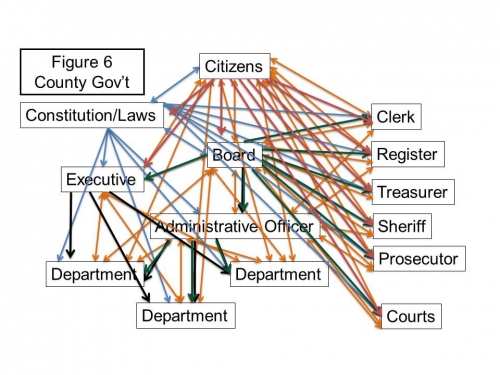The Structure of Michigan county government – Part 4
County Government in Michigan acts differently than other organizations because it is built differently; explore its complexity and learn more about the advantages it offers.
So, how do we manage all of the complexity in county government that were outlined in part one, part two and part three of this article series? Good communication between all departments yields the most effective results for the county as a whole.
I might be able to, as a department manager, acquire more money, more technology resources, more power, more “you fill in the blank” for my department through a variety of means. The question we must answer, however, is “What is the mix of services that best serves the long-term interests and needs of the entire county?”Achieving that mix, or something close to it, requires the input of all departments; it requires people to act in ways which increase trust, regardless of the current state of trust in the county. It requires effective communication.
Figure 5 illustrates the two-way communication necessary to achieve the highest levels of effectiveness across an entire county government.
One look at figure 6, which shows a combination of the previous diagrams, illustrates well the complexity of Michigan’s county government structure. In a world that craves the quick and effortless and the most efficient ways of reaching goals, are there advantages to complex governance?
There are two key advantages. The first has to do with the provision of services. County government has evolved as a provider of many services, some as a local provider on behalf of the state. Simplification would mean elimination of many of these. Many have never been well-provided by the private sector, hence, the use of governments’ ability to tax and provide for the public good.
The second advantage of complexity in government will sound strange at first, but makes sense as you think about it. While speed and efficiency are valuable in many pursuits, often including the provision of government services, the legislative process – which we use to make policy decisions – is better served by an investment of time. Most of us can cite examples of legislative decisions which were made in haste, and failed to adequately consider important facets of the problem or failed to consider some important consequences of the action. Slowing the legislative process to ensure more thorough consideration of the impacts of the proposed legislation can be a good thing. A culture of careful communication amongst all impacted parts of an organization can ultimately lead to better decision making.
Michigan State University Extension offers a variety of educational programs related to governance and citizen engagement. Use the “Find an Expert” link for more information about programs in your area.



 Print
Print Email
Email




